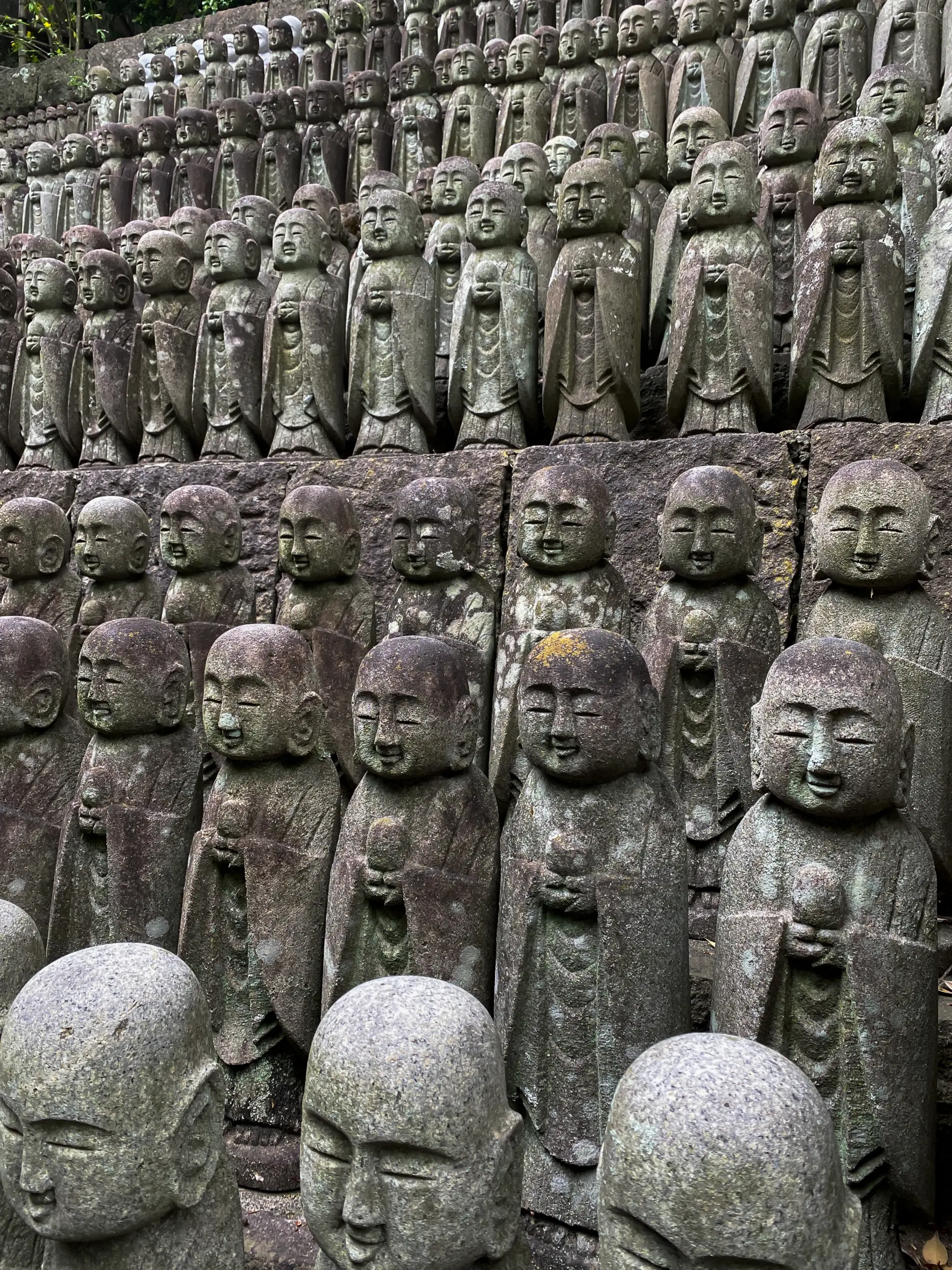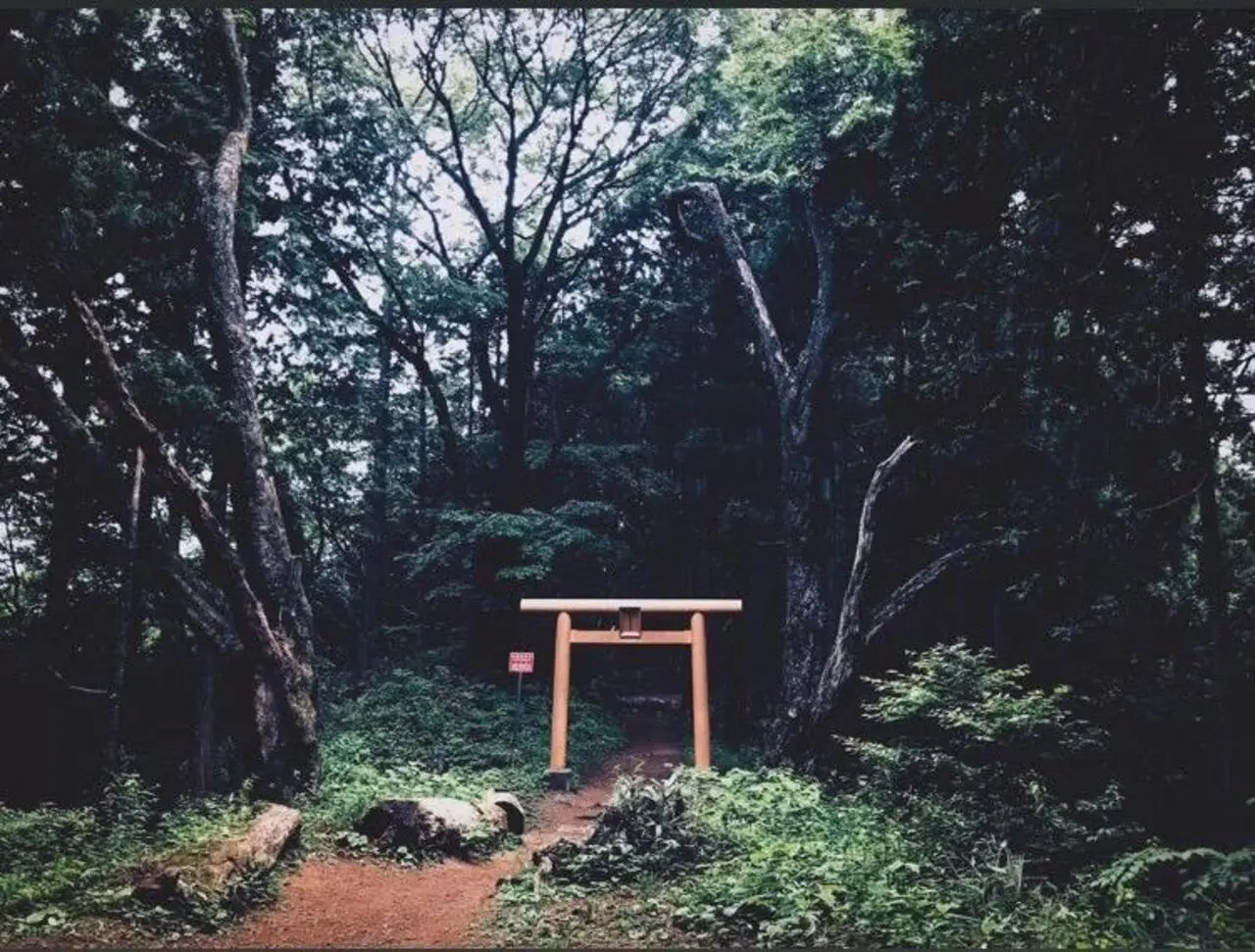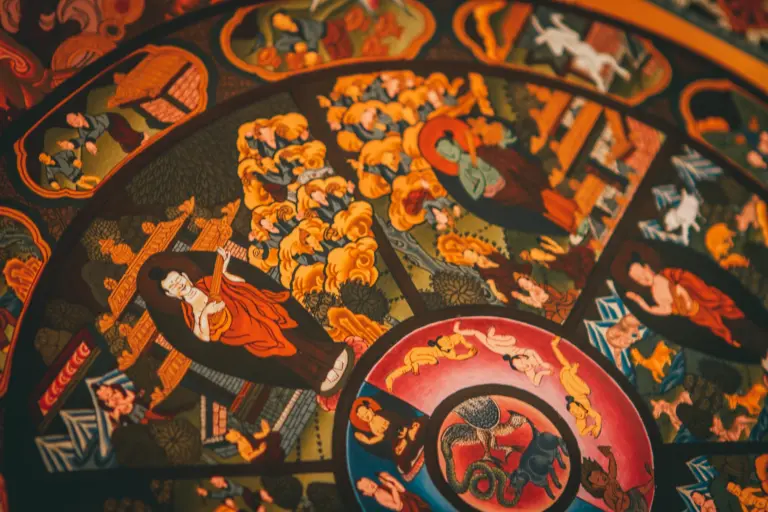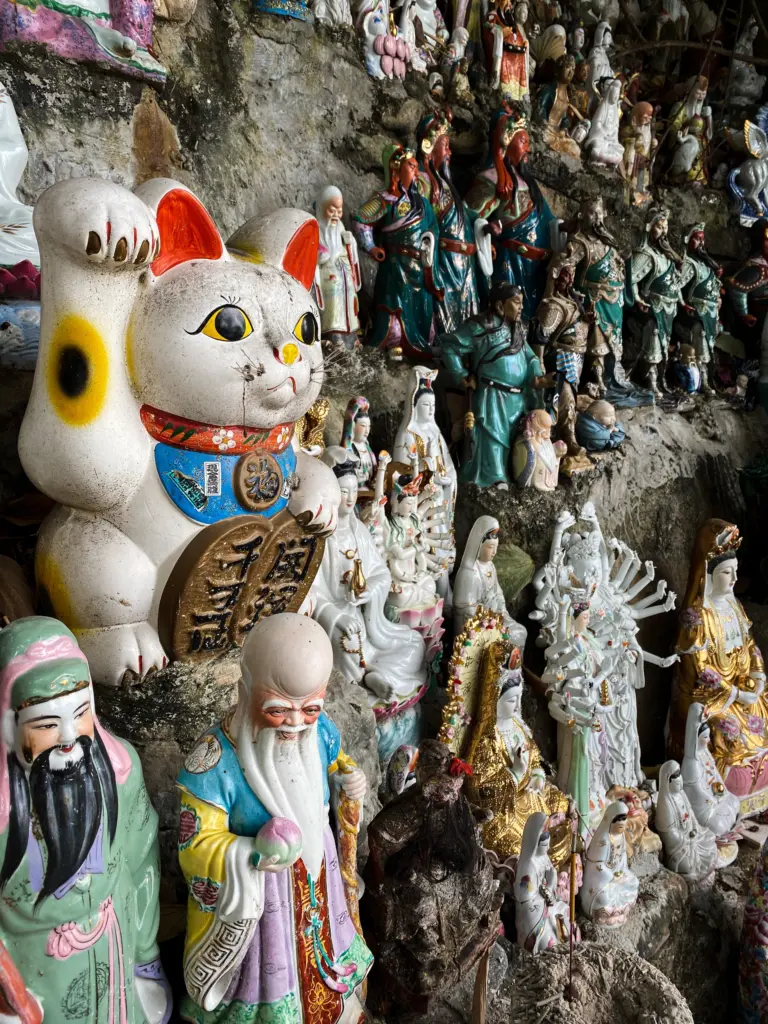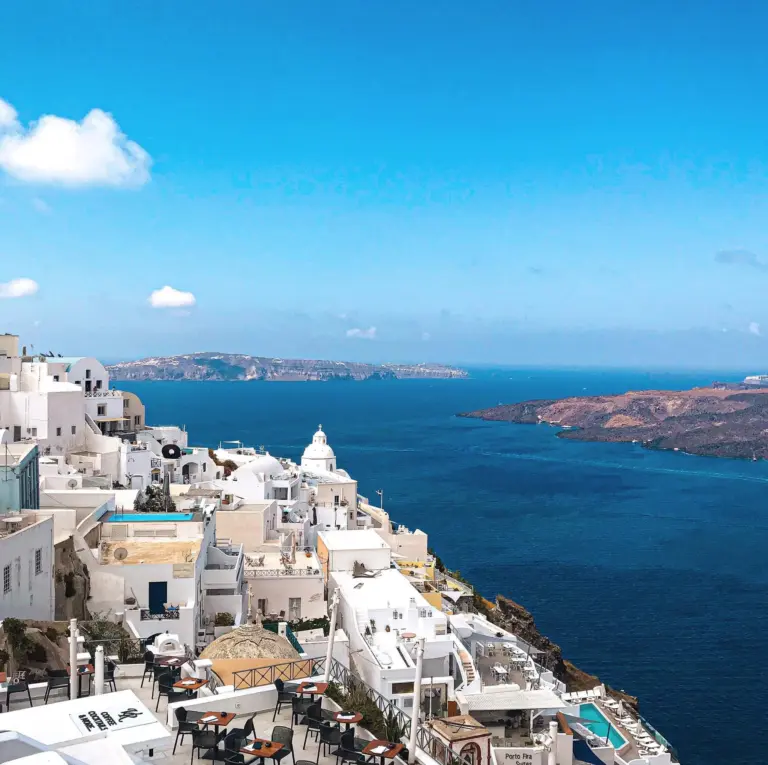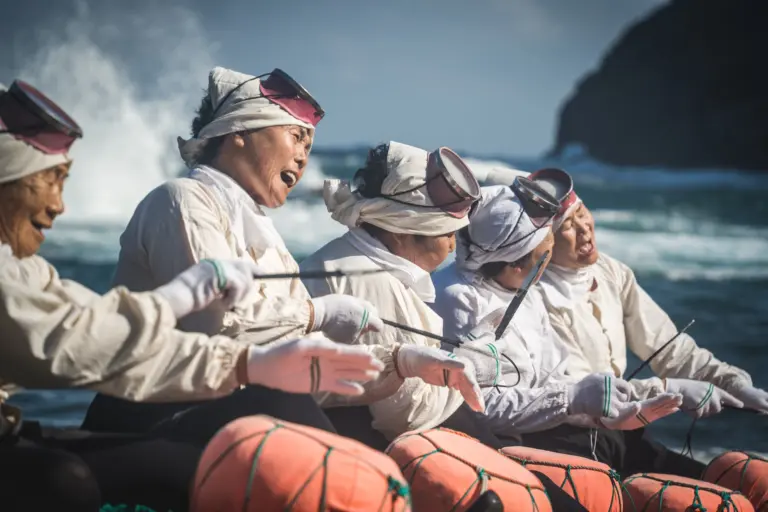I won’t sugarcoat it, Dhaka is wild.
A place where the energy never dips, the streets are always buzzing, and your senses get totally stimulated with each step. That’s Dhaka for you.
As the capital of Bangladesh; it’s the soul of an unbreakable spirit that resonates through its crowded bazaars, vibrant rickshaws, and its people.
Now, if you’re expecting some peaceful walks around its city streets, Dhaka will throw you off your game. But if you’re here to dive into the depths of culture, taste food that tingles your very soul, and experience life in one of the most densely populated cities on earth, you’re in for a treat.
Dhaka is not just a city; it’s an experience, an adventure for the brave and the bold. And no worries, this guide is here to take you through the beautiful chaos. Trust me, it’s a journey you won’t forget.
Table of Contents
Toggle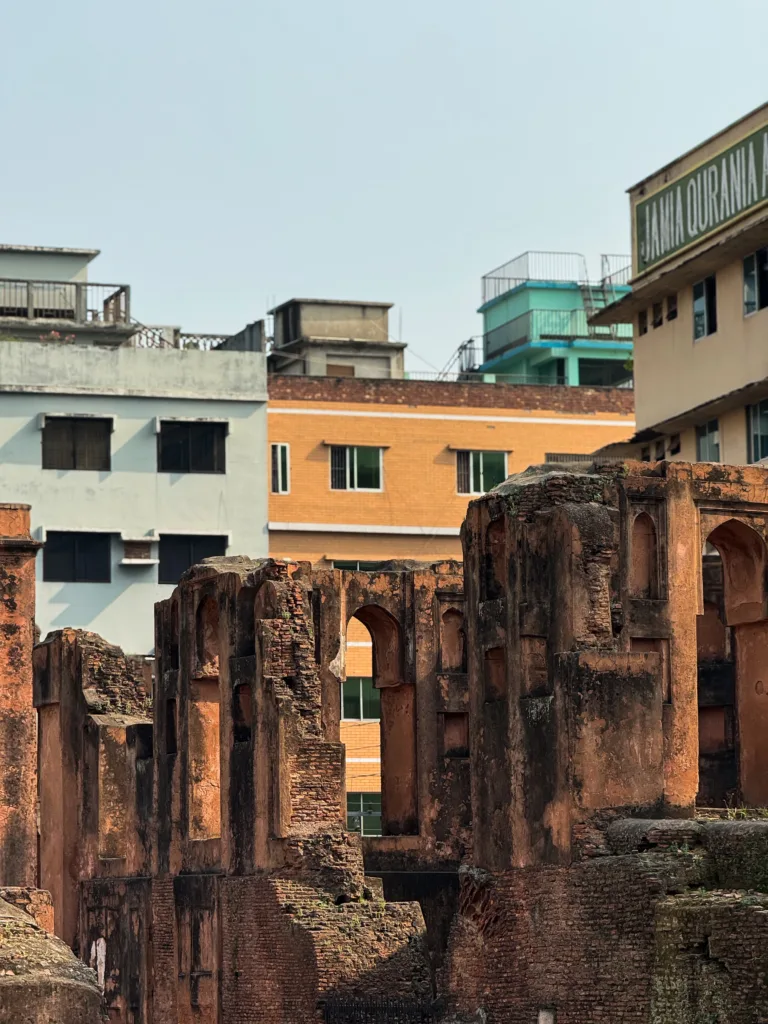
History of Dhaka
Let’s go back a hundreds of years, to when the city was buzzing with traders from across the world, and majestic ships docked at its ports. It’s a city with roots that stretch deep in history.
Originally known as Jahangir Nagar during the Mughal era in the 17th century, Dhaka blossomed into a center of trade and culture, famed for its fine muslin fabric that was sought after globally. The Mughals, who were known for their architectural prowess and sophisticated lifestyle, left a lasting imprint on the city (including the Lalbagh Fort).
It’s a city that has witnessed the tides of change, surviving colonial rule under the British, who took over in the 19th century, and later becoming the focal point of Bangladesh’s struggle for independence. In 1971, Dhaka emerged as the proud capital of Bangladesh, embarking on a new chapter that would see it grow into the bustling metropolis it is today.
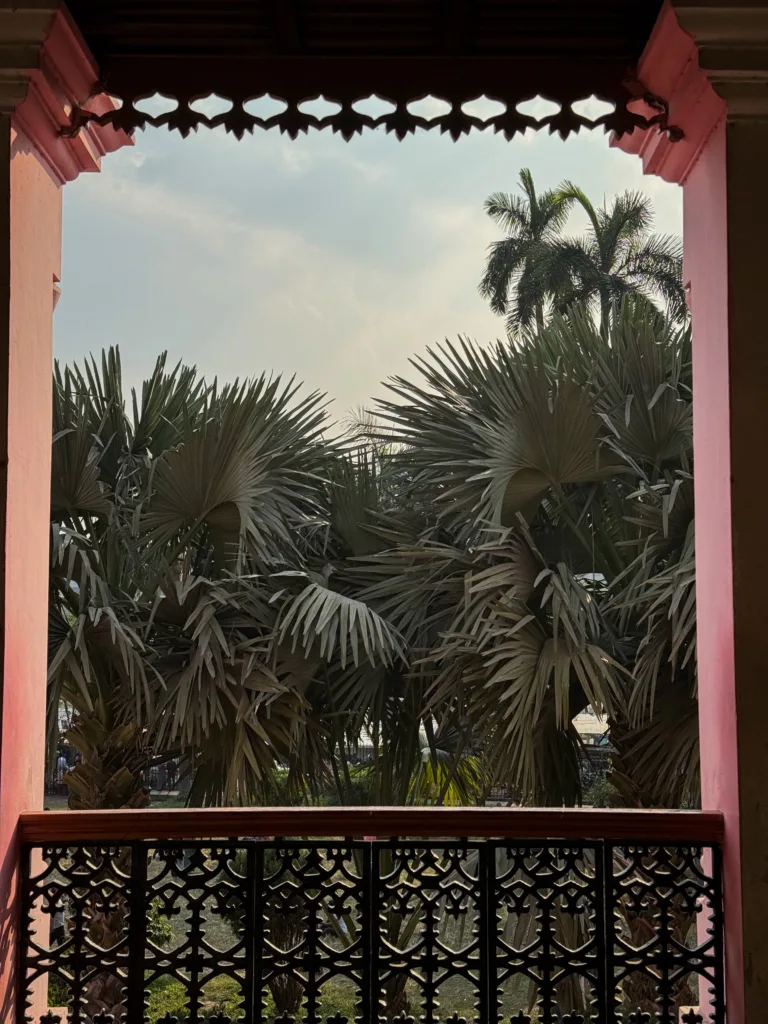
Bangladeshi Culture Overview
Bangladeshi culture is a tapestry woven with the threads of diverse influences, from ancient civilizations through the Mughal Empire to British colonialism, all leaving their mark on this land’s identity. For a deeper dive into this fascinating culture, don’t miss out on my article on Bangladeshi Culture & Traditions.
It’s also important to note the distinction between “Bengali” and “Bangladeshi” as you would most likely encounter these two terms in Bangladesh. “Bengali” refers to the ethnic group with a shared language (Bangla) and culture, primarily residing in Bangladesh and the Indian state of West Bengal. “Bangladeshi,” on the other hand, denotes the nationality of people from Bangladesh, embracing a multitude of ethnic groups and cultures within the country.
Bangladeshi culture is also a celebration of life’s moments, big and small, through its festivals. The Durga Puja and Eid celebrations showcase the country’s religious diversity (A Hindu and Islamic festival respectively) yet unified spirit.
The culinary landscape of Bangladesh is as diverse as its people, with rice and fish considered staples, embodying the saying, “Fish and rice make a Bengali.”
Best Places to Visit in Dhaka
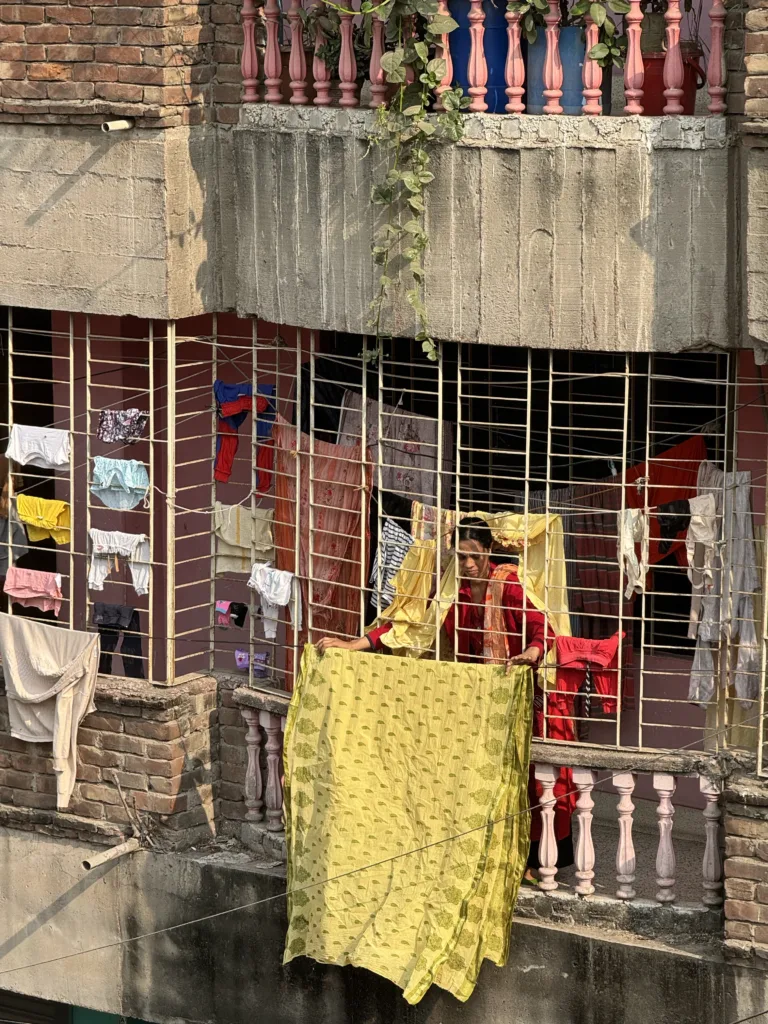
1. Old Dhaka
I won’t beat around the bush—Old Dhaka is like stepping into a whole different world. It’s the kind of place where the air is thick with the aroma of street food, spices, perfume, amongst a multitude of other things. If you’re interested, you can join a tour of Old and New Dhaka through here.
You’ll be walking down streets lined with buildings that have seen centuries come and go. You’re dodging rickshaws, sharing smiles (and stares) with locals, and every so often, you stop because something fascinating catches your eye. It’s chaotic, sure, but in the best possible way. There’s an energy here that you won’t find anywhere else in the city.
This part of town is where you get to see the real Dhaka. It’s not polished or pretentious—it’s authentic, raw, and absolutely wild. You’ll wander past markets where the locals shop, duck into a tiny tea shop for a cup of cha that hits just right, and maybe even stumble upon a hidden gem of a restaurant that serves up dishes you’ve never heard of but will dream about for days.
So, if you’re up for an adventure and don’t mind getting a bit lost along the way, Old Dhaka is the place to be. It’s an experience that’s as unforgettable as it is hard to describe, but one thing’s for sure—you’ll leave with stories to tell.
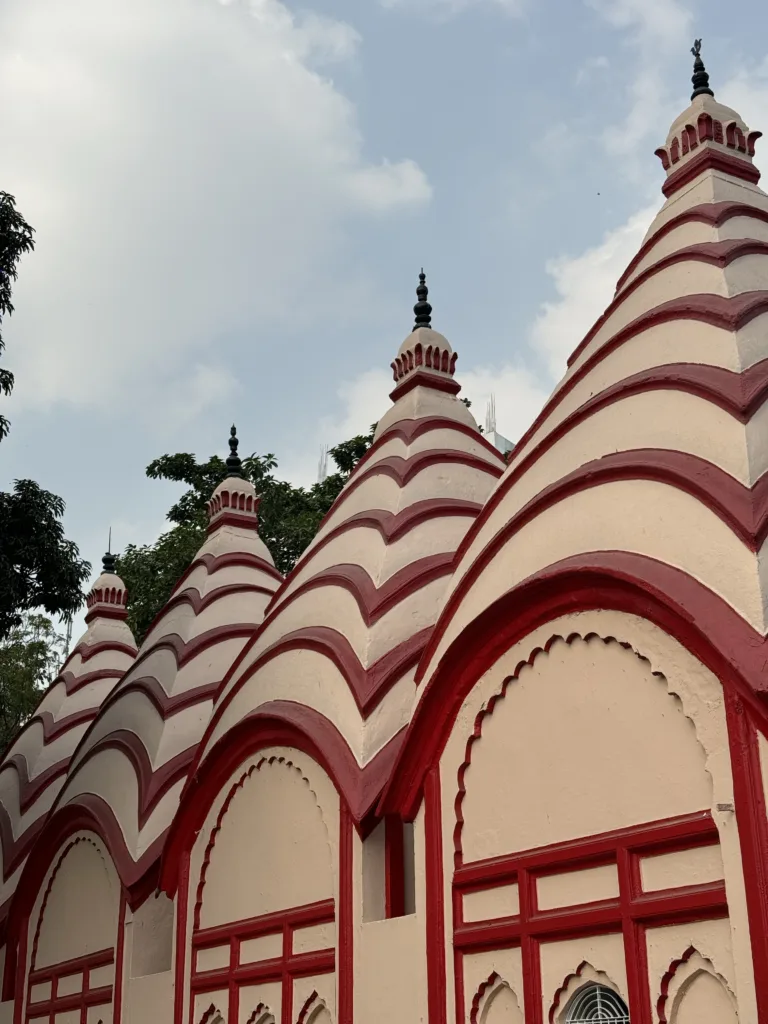
2. Dhakeshwari National Temple
The Dhakeshwari National Temple, as the name suggests, isn’t just any temple—it’s one of the few prominent Hindu temples in the city and it’s state-owned. Dhakeshwari means “Goddess of Dhaka“, and once you’re there, you’ll feel her presence. Though you can see other deities present as well including Ganesha, Durga, and Shiva.
Dedicated to the Hindu goddess Dhakeshwari, from whom the city of Dhaka is said to derive its name, the temple has stood the test of time and witnessed the city’s evolution from ancient times to modern-day Bangladesh.
Structurally, the temple complex is a fascinating sight. You’ll have to take off your shoes before entering the main temple grounds. I think the main highlight are the pink and white patterned structures that are super eye-catching even from afar.
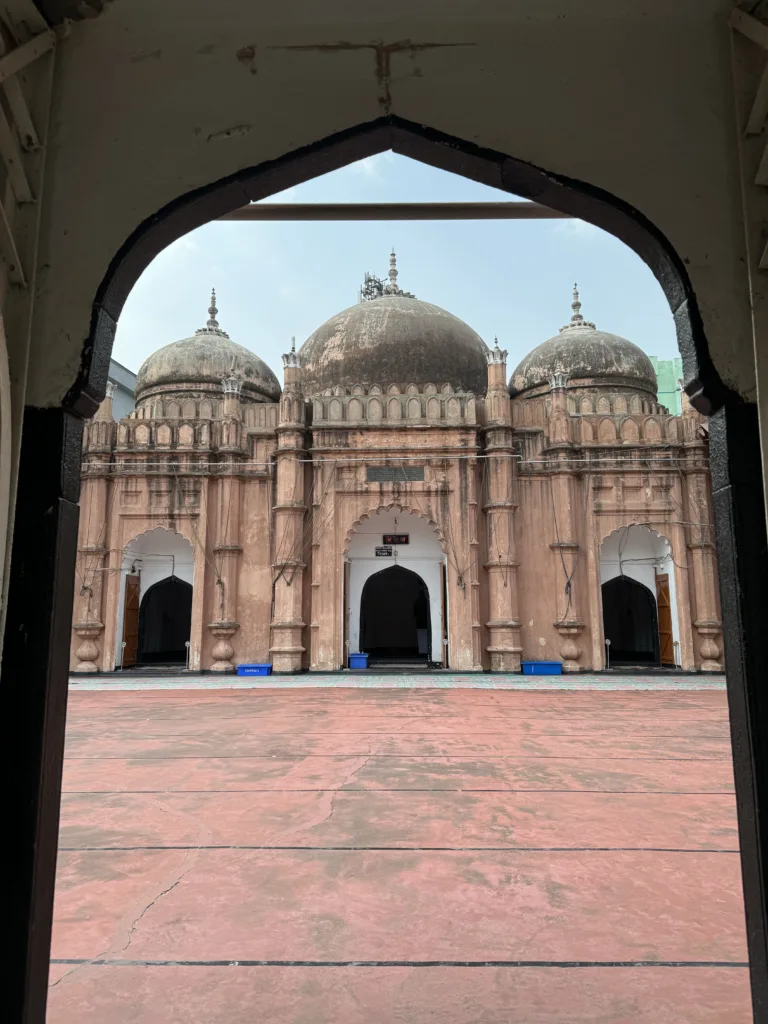
3. Khan Mohammad Mridha Masjid
Khan Mohammad Mridha Masjid is one of those places that might not make the front page of glossy travel brochures, but it’s absolutely packed with history and a sense of tranquility that’s hard to find in the bustling city.
Built in the early 18th century, the mosque sits on a high platform, accessible by stairs, which is a bit unusual for mosques from that period. This elevated design not only adds to its grandeur but also protected it from the floods that were common in Dhaka.
It’s got this Mughal architectural vibe with three domes crowning the main prayer hall and two slender minarets at the front. What’s really cool about this mosque is its blend of Mughal and pre-Mughal architectural elements.
I found the locals here to be very friendly, and you’ll most likely be the only tourist here. It’s definitely worth checking out as the upper terrace gives you a better view of the surrounding neighborhood as well.
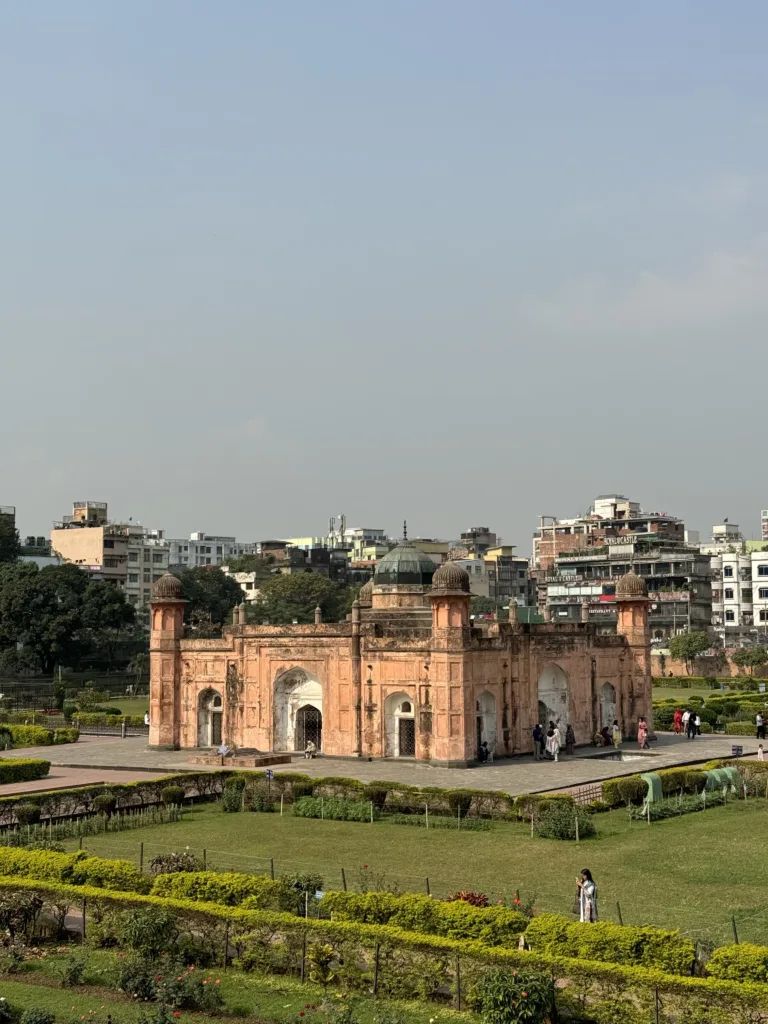
4. Lalbagh Fort
Lalbagh Fort is a story of dreams, ambitions, and an unfinished legacy that still stands proud.
Constructed in the 17th century under the orders of Prince Azam Shah, the son of the Mughal Emperor Aurangzeb, the fort was envisioned to be a magnificent example of Mughal architecture. However, as fate would have it, the fort remains incomplete to this day. Despite its unfinished status, Lalbagh Fort is a breathtaking site, with its grandiose structures and intricate designs that offer a glimpse into the lavish lifestyle of the Mughals.
Walking through the fort, you can’t help but feel transported to another time. The main components include the tomb of Pari Bibi, a mosque, and the Diwan-i-Aam, where the Mughals held their public audiences. The tomb of Pari Bibi, in particular, is a heart-touching story of loss, believed to be a major reason the construction was halted, as it cast a shadow of grief over the project.
It’s surrounded by beautifully maintained gardens that offer a serene escape from the city’s chaos. It’s a popular spot for locals as well, and it’s not uncommon for them to start conversations with you as you walk around the compound.
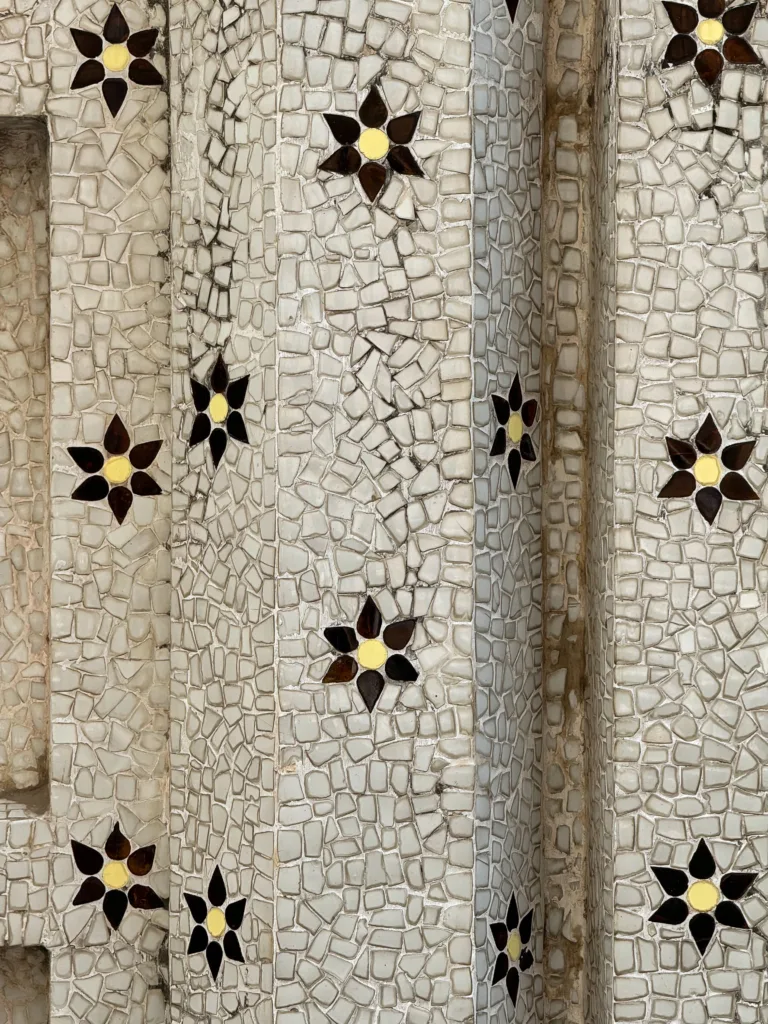
5. Tara Masjid
Originally built in the early 18th century by Mirza Golam Pir, Tara Masjid’s modest beginnings belied the astronomical wonder it would become. It was later in the 20th century that a local businessman, financed an expansion and adorned the mosque with the tiles that would earn it the name “Star Mosque.”
Step inside, and you’re enveloped in a galaxy of tiles, with stars twinkling back at you from walls, domes, and archways. The mosque is covered in black, white, and yellow tiles, with patterns that mimic the night sky. It’s not just the design that captures your imagination; it’s the meticulous detail in every tile, every pattern, that tells you this place is something special.
It’s still an active place of worship yet it welcomes all who come in peace. Just be sure to be respectful especially during the times of prayer.
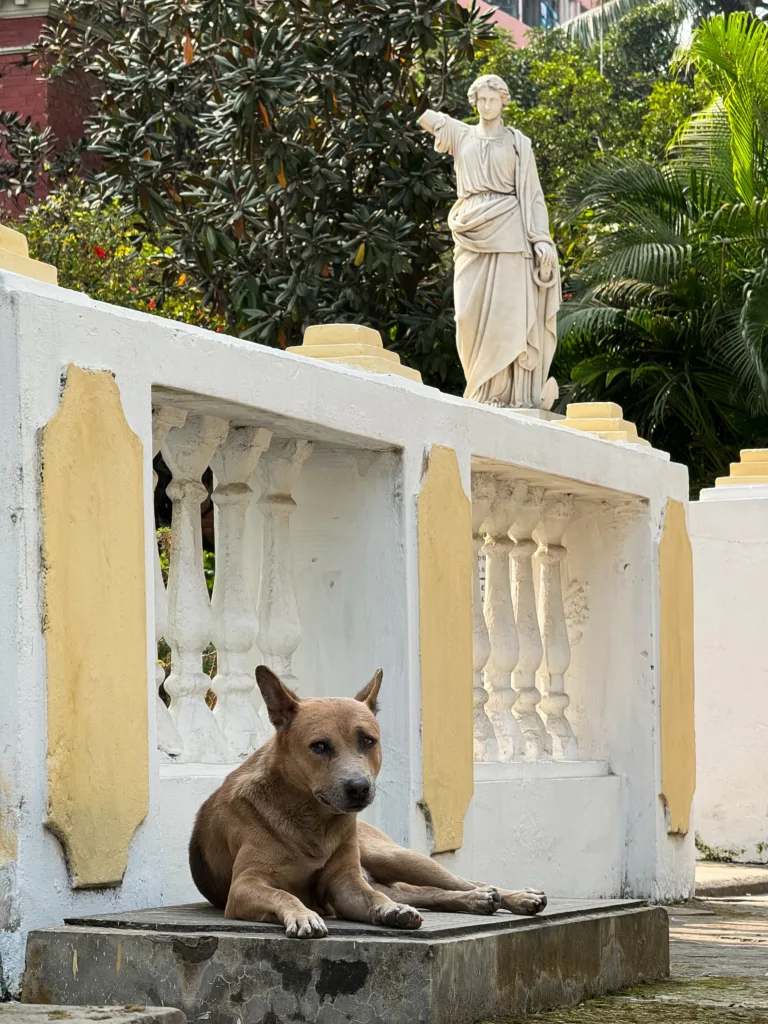
6. Armenian Church
The Armenian Church. Imagine a little oasis where the noise of the city fades into the background and you’re once again in a place of peace. That’s this place. And take it from me, it’s hard to find places of solace in Dhaka so we have to take what we can get before we venture out into the fray.
The Armenian Church isn’t just about the beautiful, old architecture, though that alone is pretty cool. It’s a peek into the lives of the Armenian community that once thrived here in the 1700s. These folks were part of the city’s vibrant trade scene, and this church was their gathering spot, a slice of home away from home.
Walking through, you’ll notice it’s kept in great shape. There’s a peaceful vibe that makes you slow down and take it all in – the detailed archways, the quiet graveyard with its ancient tombstones.
You can actually go up to the upper floor and out onto the rooftop, but you can even go higher than that if you climb the ladder. You’ll get an amazing view of Dhaka’s bustling streets and apartments.
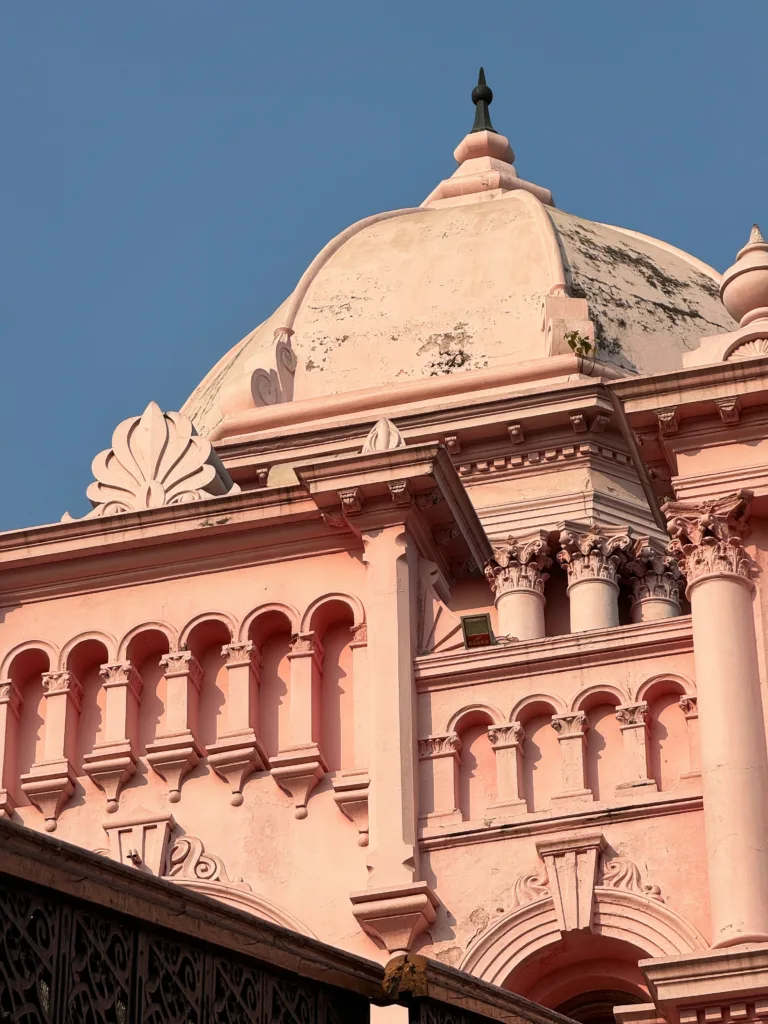
7. Ahsan Manzil Museum
Ahsan Manzil Museum is one of those places in Dhaka that kind of stops you in your tracks. Right on the banks of the Buriganga River, this massive pink palace doesn’t just stand out because of its color. It’s a dive into the luxurious world of the Nawabs of Dhaka, showing off what high living looked like back in the day.
Back in the 19th century, this was the spot where the Nawab of Dhaka had his digs. We’re talking big parties, important political meetings, and all the lavish lifestyle you can imagine from that era. Nowadays, turned into a museum, Ahsan Manzil is a window into that opulent past.
But let’s dial back to the main color at hand: pink. The Pink Palace is easily one of the most photogenic and Instagram-worthy places of Dhaka and at sunset the colors are even more vibrant!
Hidden Gems in Dhaka
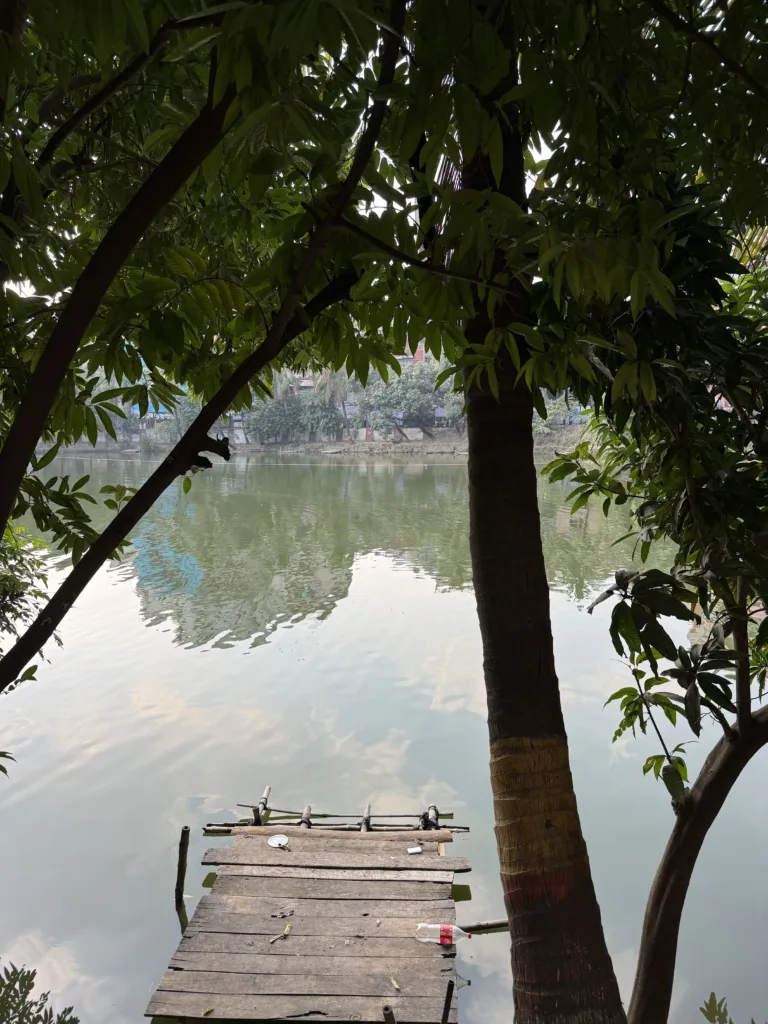
8. Gol Talab
Gol Talab is this pretty little pond tucked away in the older part of Dhaka, in a neighborhood called Islampur. It’s a spot that might not make the big tourist maps, but for those in the know, it’s a slice of local life that’s worth checking out. It’s a bit hard to get to and I had to ask for some directions that took me through an underground pitch-black alley but I did make it to the other side.
What’s cool about Gol Talab is that it’s a perfectly oval-shaped pond smack-dab in the middle of the city and it’s even been designated as a heritage site by the government!
9. Ruplal House
Ruplal House is not as widely talked about as some of the other landmarks, but if you’re the type who loves digging into the lesser-known pages of history, this place is a gem. I wasn’t able to make it here just because I was already too tired and I couldn’t bring myself to go on another long journey through Dhaka’s crazy streets.
Built in the late 19th century, Ruplal House was once a symbol of opulence in Farashganj, a reminder of the wealth and cultural sophistication of its owners, the Ruplal brothers. These guys were among the city’s elite, and their residence was a hub of social gatherings. The architecture of Ruplal House is a fascinating blend of European influences with traditional Bengali elements.
Today, Ruplal House stands in a state that cries out for preservation. Walking past or through it, you can’t help but feel a mix of awe and a slight twinge of sadness. Awe, because even with the wear and tear, the grandeur of its design and the stories it must hold are palpable. Sadness, because it’s clear that without some love and attention, more of its stories could be lost to time.
Top Things to Do in Dhaka
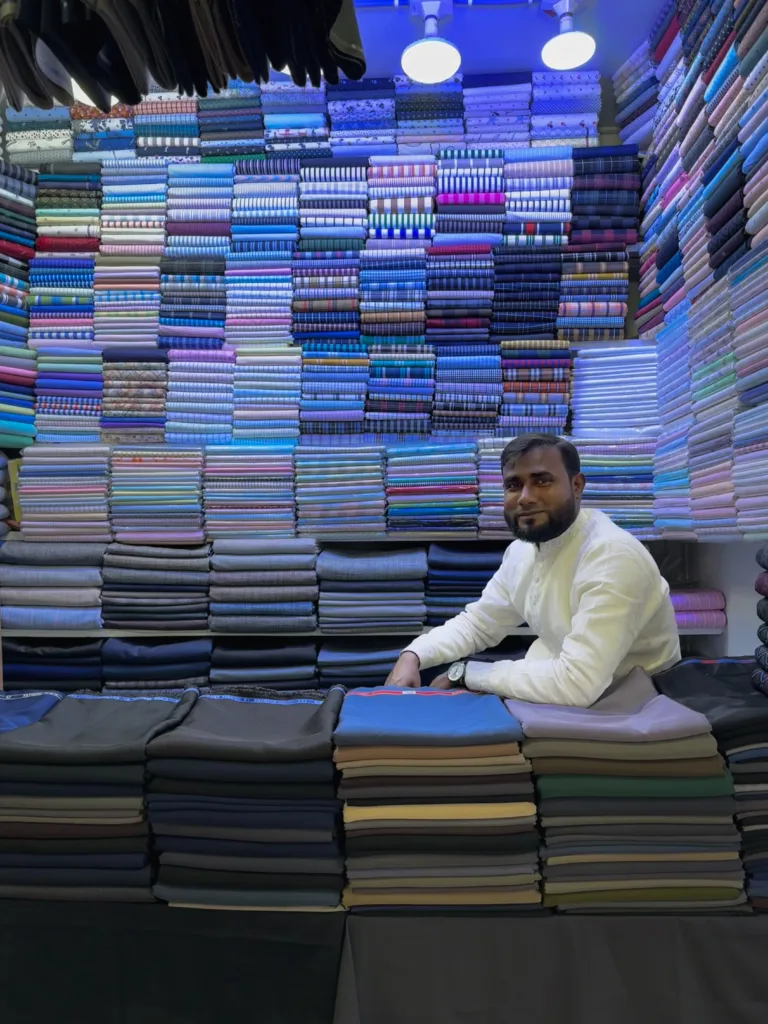
10. Shop at Chawkbazar
Alright, if really want to see Dhaka, you’ve got to wander through the bazaars, and Chawkbazar is a prime spot for this.
Chawkbazar isn’t just a place to shop; it’s like the city’s pulse with streets buzzing with energy, stalls overflowing with colorful goods, and the air rich with the scent of spices and street food. This is where you get a real taste of Dhaka’s street life. It’s loud, it’s crowded, and it’s absolutely brilliant.
Hidden in this bustling market scene is the Chawkbazar Shahi Jame Masjid, a historic mosque that offers a peaceful counterpoint to the market’s frenzy. But you’re gonna have to tell me what it’s like though because I never did find the mosque. I was simply too overwhelmed and couldn’t bring myself to keep going deeper into the urban jungle.
Still, it’s could be an expedition of some sort, just keep your wits about you and stay safe in there!
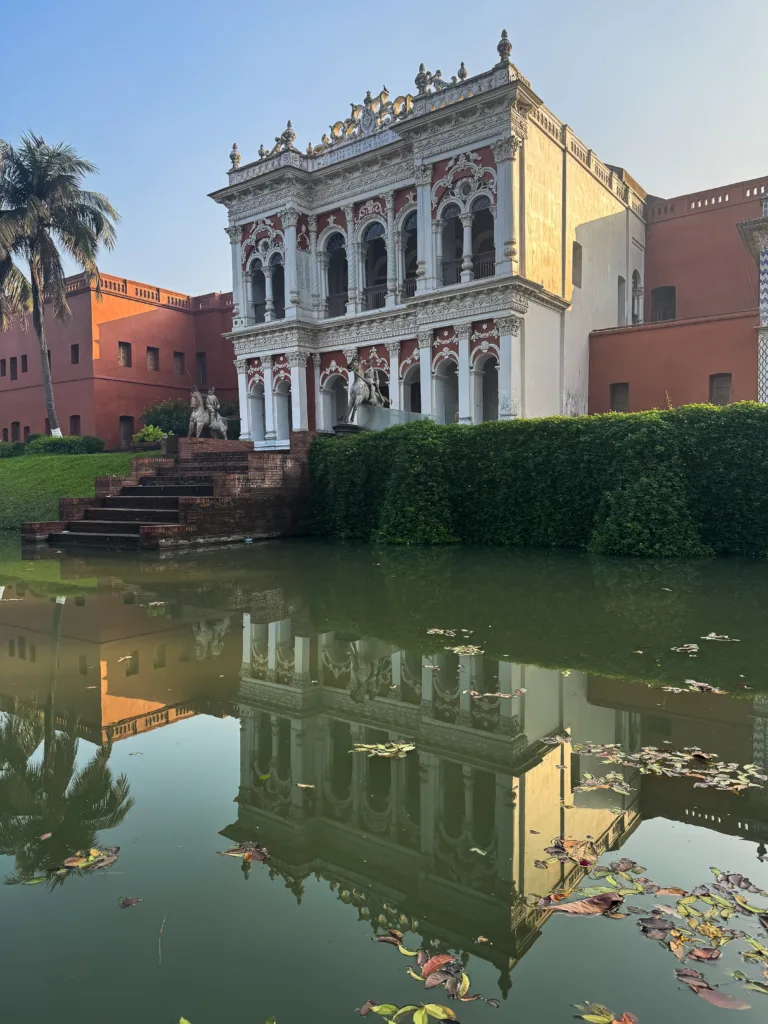
11. Take a Day Trip to Sonargaon
Heading out of the city for a bit? Sonargaon is the perfect day trip from Dhaka. I was actually able to do this in the morning before exploring Old Dhaka in the afternoon.
Sonargaon, which translates to “City of Gold,” was once the capital of ancient Bengal in various phases of history. The star attraction here is Panam City, an abandoned yet remarkably preserved part of Sonargaon. Walking down its main road, lined with the ruins of magnificent colonial-era buildings, feels eerily like time travel. These structures once housed the wealthy merchants of the region, and though they now stand empty.
The Folk Art and Crafts Museum is a colorful showcase of Bangladesh’s living traditions, though the best shot is the one taken from outside with a reflection of it by the pool.
And then there’s the natural side of things. The area around Sonargaon is dotted with rivers and lush greenery, giving you a look at what rural life is like and it’s honestly so much better than Dhaka, but don’t take it from me! See it for yourself!
12. Check Out the Bangladesh National Museum
From the moment you step in the National Museum, you’re greeted with a vast collection that spans several floors, each dedicated to different aspects of Bangladeshi life. There’s something almost overwhelming but in the best way possible about the depth and breadth of what’s on display.
You’ve got galleries filled with ancient Bengal artifacts, exhibits on the flora and fauna of the region, and even sections dedicated to the struggle for independence. It’s all there. There’s an entire section devoted to folk art and there are contemporary art galleries.
So, if you find yourself in Dhaka with a few hours to spare, the Bangladesh National Museum is well worth your time, especially if history is important to you.
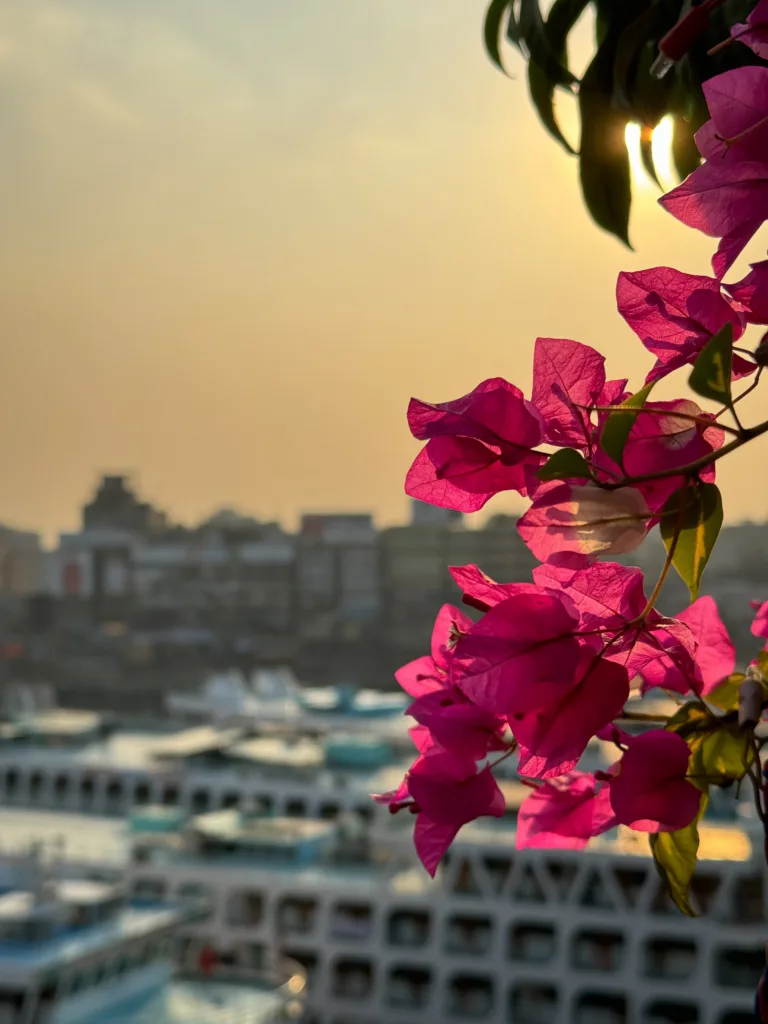
13. Dine at Buriganga Riverview Restaurant
The Buriganga River is the lifeline of Dhaka, and dining alongside its banks gives you a front-row seat to the river life that defines the city. From the early morning fishermen in their wooden boats to the colorful hustle of the river traffic throughout the day, it’s a snapshot of Dhaka from a perspective not often seen.
I accidentally found the Buriganga Riverview Restaurant while walking towards Ruplal House but ended up eating an early dinner and watching the sunset here instead. The food and service is top-notch and if you’re afraid of trying out the streetfood and other street restaurants then I highly recommend this place as the quality and ambiance is really high. It seems to be a popular place as there were signs that said “No Food Bloggers Allowed.”
14. Ride a Rickshaw
Forget about Uber, ride a rickshaw! The quintessential mode of transport in Dhaka. It’s an adventure that lets you dive headfirst into the busy streets, all from the unique vantage point of a colorful, often intricately decorated, three-wheeler.
Weaving through the bustling traffic, the sounds of the city buzzing around you, as you take in sights and sounds that you’d miss from the confines of a car. Rickshaws open up a whole new perspective on Dhaka, bringing you up close to the daily lives of its people. You’ll pass by local markets spilling onto the streets, dodge alongside buses and cars in a dance that seems chaotic but flows like a well-practiced routine though I must say I still saw some small bumbs and scraps every now and then.
What makes rickshaw rides truly special in Dhaka is their cultural significance. They’re not just a mode of transport; they’re a part of the city’s identity, an art form on wheels.
But beyond the cultural flair, riding a rickshaw is about connecting with the city on a human level. Understand that this is their livelihood and it’s one heck of a job to be pedalling people the whole day, without any technological supports. It never hurts to give a bit more if you can afford to.
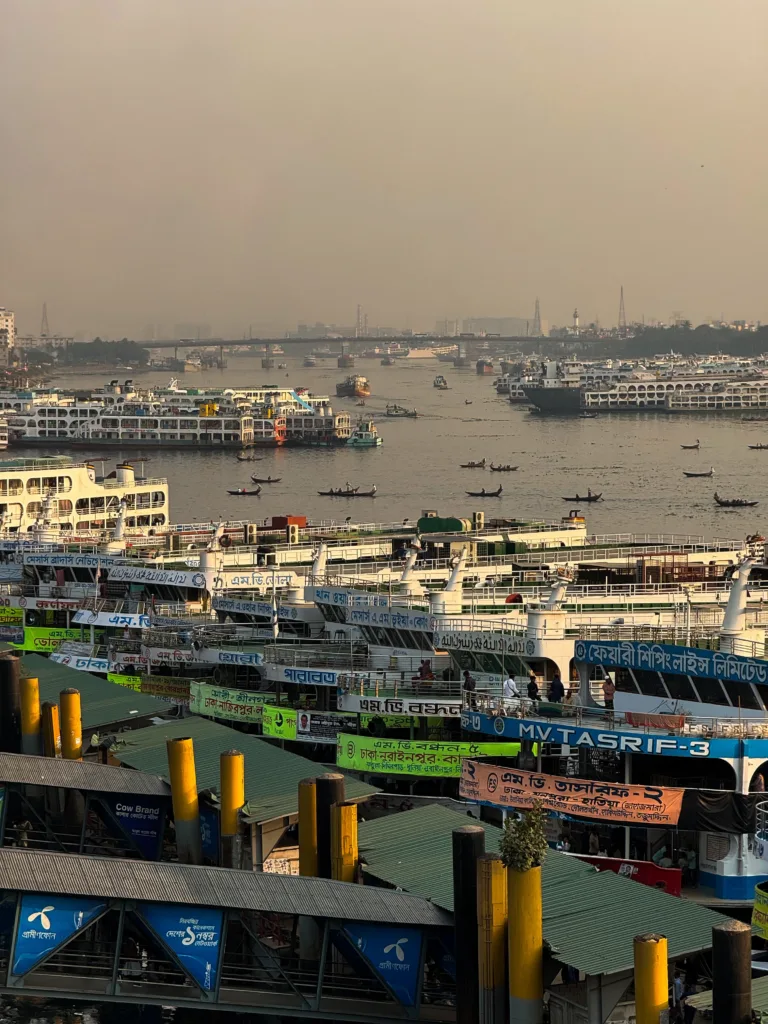
15. Watch the Sunset at Sadarghat
If you’re not too keen on the riverside restaurant, ending a day in Dhaka with a sunset at Sadarghat is still something truly special. Around you, the day’s hustle begins to slow, but the energy of Sadarghat lingers, with boats of all sizes winding down their day’s work. It’s here, amidst the chaos of coming and going vessels, that you find a moment of profound beauty.
You’re surrounded by the rhythm of daily life—fishermen securing their boats, vendors making their last sales, and families gathering to enjoy the cooler evening air. The sunset here tells the story of the city—a blend of relentless energy, timeless tradition, and natural beauty.
It’s also a photographer’s dream, I mean I couldn’t stop snapping because with every passing minute the Golden Hour just keeps giving! But even without a camera, sitting by the river and watching the day turn into night is a moment you’ll want to hold onto.
Where to Stay in Dhaka
When looking for accommodations in Dhaka, I prioritize peace and safety. You must have read many times by now but Dhaka is a noisy city, a city that never sleeps. The worst thing is to have your sleep taken away from you when you still have plenty of days to explore. Safety is another prime factor, being in a safe neighborhood, away from the crowds can give you that sense of peace which is highly relevant in this city. Here are some of my recommendations on where to stay:
Best Hotels in Dhaka:
- Nascent Gardenia Residence – this is where I personally stayed. It’s in a quiet and cozy neighborhood in Gulshan area. Make sure to put the right one in on your Uber as there’s also another Nascent Gardenia that I mistakenly ended up in which was like an apartment. On the booking website, they mentioned that free airport shuttle is included though they did try to charge me at first when I asked for it. And the shuttle actually was not there when I arrived which put a bit of a sour taste in my mouth. But! They more than made up for it though, the place was perfect. Big and comfortable beds, spacious and quiet rooms. The bellboy was extremely polite and kind, always happy to assist. The bathroom’s shower worked perfectly and came with various toiletries and other amneties including water and fruits. Breakfast is a buffet with a great selection. They also offered me a shuttle back to the airport but I didn’t need it as I was heading to Khulna. All in all, I highly recommend it, just be on the same page and follow up with the airport shuttle as we discussed that a month back so perhaps it got lost.
- Hotel the Capital Ltd. – provides a range of amenities including a fitness center, complimentary WiFi, and on-site parking at no extra cost. This 3-star establishment not only features round-the-clock front desk and concierge services but also caters to families with a kids’ club, offers room service, and facilitates currency exchange. You’ll have the option to dine at the hotel’s restaurant, which serves a variety of Chinese, Indian, and Italian dishes, with special dietary requests such as vegetarian, halal, and vegan meals accommodated.
- InterContinental Dhaka – Experience the luxury of celebrity-like treatment at InterContinental Dhaka, an IHG Hotel. This lavish 5-star hotel boasts an array of upscale facilities, including an outdoor swimming pool, a state-of-the-art fitness center, a serene garden, and a sophisticated restaurant complemented by a chic bar. You’re welcomed around the clock at the 24-hour front desk and can enjoy the convenience of airport transportation, room service, and complimentary WiFi across the premises.
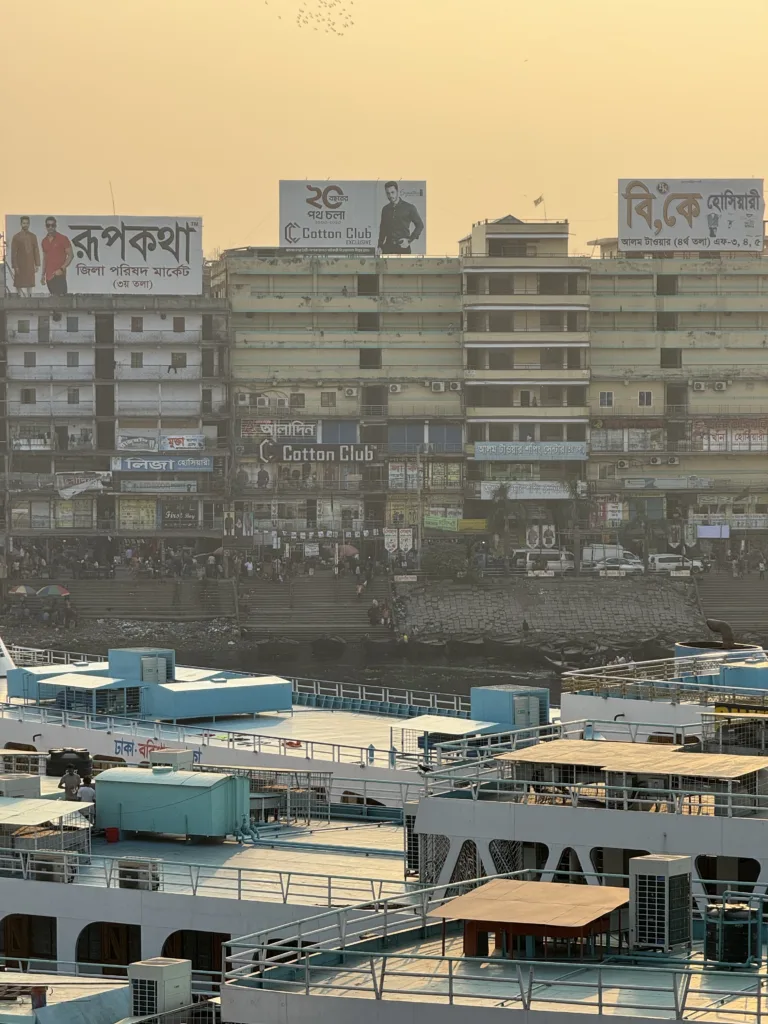
How to Get Around Dhaka
Getting around Dhaka is an adventure in itself, and I mean that. If you want a thrill go for the motorbikes, they are cheaper and the adrenaline you get from weaving across traffic is really something else. I always make sure to pay my driver more just because making it out unscathed seems like a miracle. Still, the traffic is one thing to consider, two-wheelers can get you to where you need faster than CNGs and four-wheeled vehicles. I recommend using Uber and it’s easy to hail any of the modes of transport listed on here. Here’s a breakdown:
- Taxis: The traditional yellow taxis are a staple on Dhaka’s roads. They’re a bit of a step up from rickshaws in terms of comfort and can be hailed off the streets. Just be prepared to haggle over the fare since most don’t use meters. Again, Uber is your friend here.
- Auto Rickshaws (CNGs): Auto rickshaws, locally known as CNGs due to their compressed natural gas fuel, are like motorized rickshaws with a small cabin for passengers. They’re nimbler than cars in traffic and cheaper than taxis, plus you’ll feel a bit safer inside the cabin as opposed to rickshaws and motorbikes.
- Rickshaws: For shorter distances and a truly local experience, you can’t beat a rickshaw ride. It’s an eco-friendly option and provides a livelihood for many.
- Motorbikes: Another option through ride-sharing apps is booking a motorbike ride. It’s the quickest way to get around, especially during peak traffic hours, as bikes squeeze through gaps that cars can’t. Helmets are always provided, all you can do is trust that the driver knows these roads like the back of his hand, which they often do.
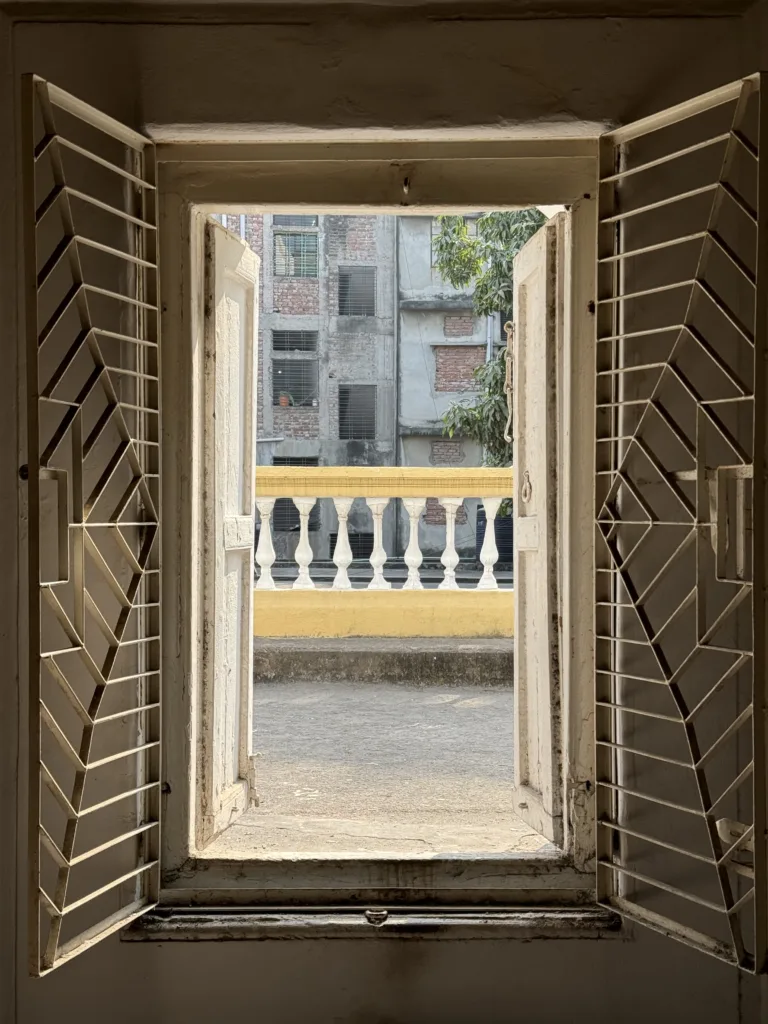
How to Stay Safe in Dhaka
Now let me get real with you. Dhaka is generally an okay place, as a foreigner you will catch attention and I personally found that people tend to stare. It’s hard not to stand out, but just do your best and ignore it. People are naturally curious. Wearing sunglasses or a balaclava can help.
It’s also a fact that Dhaka is one the most polluted cities on Earth. There’s garbage everywhere and the scents intermingle with the heavy perfumes, incense, spices, and food which completely barrages the senses. I highly recommend wearing a mask. In fact, I would say it’s a requirement. I literally got sick the same night on the first day of exploring just because I wanted to experience the city “unfiltered.” Regrets were made. That cough stayed with me the whole time I was in Bangladesh, from Bagerhat to the Sundarbans and all the way to Nepal.
Not to mention the crowds, it’s really crowded, like you’ll have to creatively maneuver just to get from point A to B. And oh the traffic, the horns of rickshaws blaring incessantly. All of these factors combined clearly takes a mental toll and a 5 minute walk really takes a lot of energy. But I never did encounter anything untoward (though I did get sexually harassed in Sonargaon), still, you should always keep your wits about you and keep your valuables close.
As for the food, sticking to vegetarian meals or fancier restaurants should give you that sense of peace. In the end, Bangladesh is one of the few countries that I highly recommend getting travel insurance for when going.
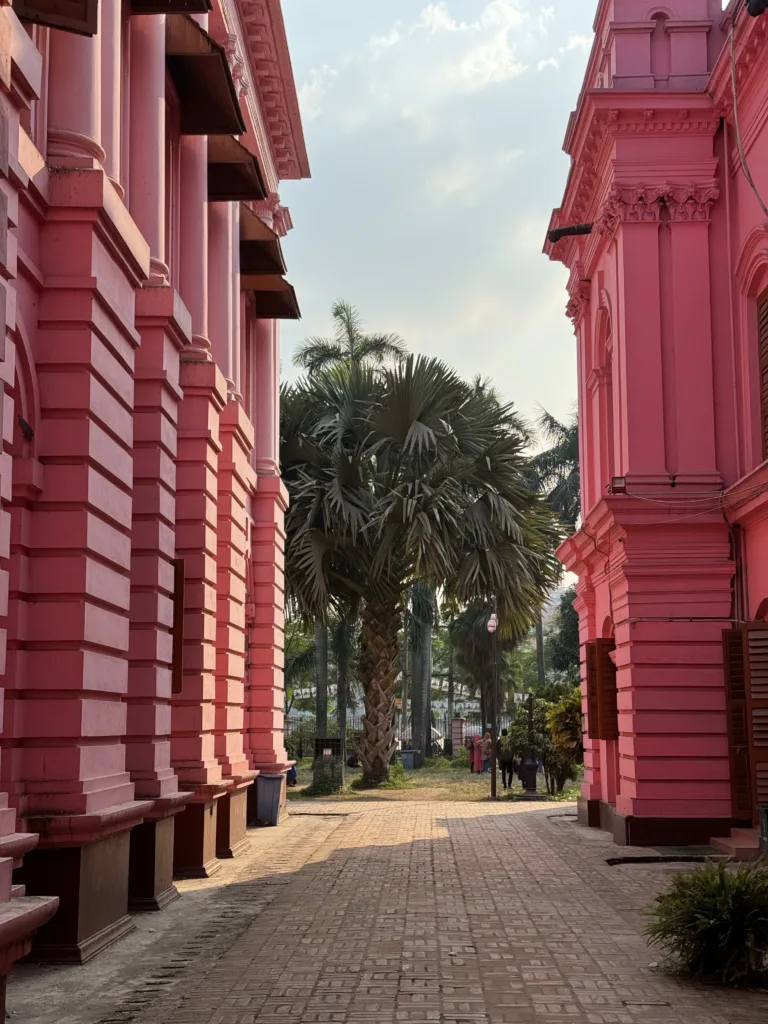
Best Time to Visit Dhaka
The best time to visit Dhaka is during the cooler, drier months from November to February. During this period, the weather is more pleasant, making it easier to explore the city without the discomfort of the intense heat or monsoon rains that characterize other times of the year. Temperatures during these months can range from about 15°C – 26°C (59°F – 79°F).
Do keep in mind, however, that this is also the peak tourist season, so you might encounter more crowds at popular attractions and potentially higher prices for accommodations. Planning and booking in advance can help mitigate some of these issues.
Plan Your Trip to Dhaka | Best Travel Resources
Book Your Accommodations
- Booking.com – the world’s leading online booking platform for accomodations around the world, they have an extensive amount of available listings with zero booking fees and best price guarantees.
- Hostelworld – a backpacker’s best friend, Hostelworld has the largest collection of hostels and guesthouses for affordable prices.
Don’t Forget Insurance
- SafetyWing – from Nomad Insurance, an insurance by nomads for nomads. They understand our lifestyle well and have really comprehensive and flexible plans that cater to any traveler.
Find Cheap Flights
- Kiwi.com – my go-to for booking and finding the cheapest flights and it’s helped me save tons of money. They do virtual interlining which is connecting flights from airlines that do not codeshare, so you can find routes that you wouldn’t be able to find normally.
Join Tours & Activities
- GetYourGuide – is one of the best places to find unique tours and activities. I found that it’s an excellent way to meet fellow travelers and create fond memories. They are not only limited to tours as they also offer niche services such as skip-the-line tickets or private transfers.
Catch a Ride
- Rentalcars.com – nothing beats the freedom of the road, Rentalcars.com is the world’s largest online car rental service. They operate across 160 countries so they’re the perfect partner to work with if you find yourself wanting a ride.

